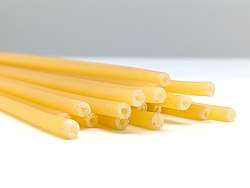Bucatini
Bucatini [bukaˈtiːni], also known as perciatelli [pertʃaˈtɛlli], is a thick spaghetti-like pasta with a hole running through the center. The name comes from Italian: buco, meaning "hole", while bucato or its Neapolitan language variant perciato means "pierced".[1][2]
 | |
| Alternative names | Perciatelli |
|---|---|
| Type | Pasta |
| Place of origin | Italy |
| Main ingredients | Durum wheat flour, water |
| Variations | ziti, zitoni |
Bucatini is common throughout Lazio, particularly Rome. It is a tubed pasta made of hard durum wheat flour and water. Its length is 25–30 cm (10–12 in) with a 3 mm (1/8 inch) diameter. The average cooking time is nine minutes. In Italian cuisine, it is served with buttery sauces, pancetta or guanciale, vegetables, cheese, eggs, and anchovies or sardines.
One of the most common sauces to serve with bucatini is the classic Amatriciana sauce, bucatini all'amatriciana. It is traditionally made with guanciale, a type of cured meat taken from the pork jowl. [3]
Similarly, ziti [ˈdziːti] are long hollow rods which are also smooth in texture and have square-cut edges; "cut ziti" are ziti cut into shorter tubes.[4] There is also zitoni [dziˈtoːni], which is a wider version of ziti.[5]
Preparation
Standard pasta machines will roll out sheets of flat pasta which are then cut into ribbons to make flat, ribbon-style pasta like fettuccine, tagliatelle, or pappardelle. Bucatini, on the other hand, has to be extruded rather than rolled.
The pasta dough is fed into a machine that forces it through a perforated disk, very similar to a meat grinder. The shape of the pasta depends on the shape of the perforations. Bucatini is made with a disk with tiny circular perforations, which forces the pasta dough to emerge in long tubes. The tubes are then trimmed off to the desired length and then either dried or cooked fresh.
Bucatini can be made at home with a stand mixer and a pasta extruder. Since bucatini has a hole in the middle, it must be handled gently so as not to squeeze the hole shut prior to eating. [6]
See also
References
- Giacomo Devoto, Gian Carlo Oli, Il Devoto-Oli. Vocabolario della lingua italiana, edited by Luca Serianni and Maurizio Trifone, Le Monnier.
- "Perciare in italiano". Glosbe - Il dizionario multilingue on line. Retrieved 2015-11-16.
- "Bucatini Pasta and How to Use It". TheSpruceEats. Retrieved 2018-08-24.
- "Cook's Thesaurus: Pasta Tubes". Foodsubs.com. Retrieved 2013-02-21.
- "Type Of Pasta". Thenibble.com. Retrieved 2013-02-21.
- "Bucatini Pasta and How to Use It". TheSpruceEats. Retrieved 2018-08-24.